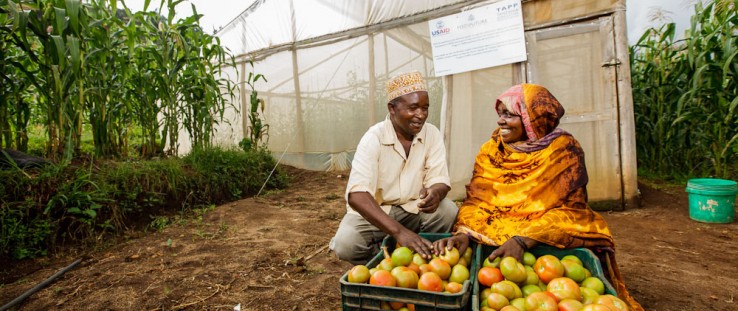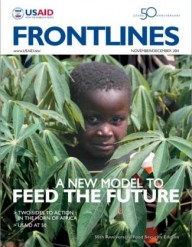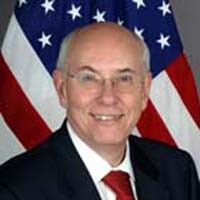 Tanzania Greenhouses Increase Yields
credit: USIAD
Tanzania Greenhouses Increase Yields
credit: USIAD
 Tanzania Greenhouses Increase Yields
credit: USIAD
Tanzania Greenhouses Increase Yields
credit: USIAD
FrontLines: You helped stand up USAID’s new Bureau for Food Security to lead the government’s Feed the Future initiative. What aspects of the initiative do you think are the most exciting, and how do you think it will impact global hunger in the next several years?
GARVELINK: Well, I think the initiative is an interesting one because of the elements it pulls together, in a way that has never been done before. The primary focus of the initiative is small farmers. That focus demands an emphasis on gender issues because most small farmers in the developing world are women. Of course, nutrition is an important element of this.
The initiative looks at the entire value chain, so the U.S. Government can intervene in any way, from providing seeds to marketing products; whatever’s needed. It’s a broad initiative geared toward reducing poverty through agriculture-led growth and improved nutrition. Feed the Future has a heavy emphasis on research, which is critically important to its long-term success. Growing populations and fewer resources mean we have to be much more innovative in figuring out how we’re going to grow more food on less land.
What will ensure the sustainability of this initiative is its emphasis on the private sector. If the initiative works properly, the role of the private sector will steadily increase and the role of USAID will decrease.
What we see in the Feed the Future initiative is the entire U.S. Government’s involvement, both bilaterally and multilaterally. That has never really happened before. The final critical element of this initiative is the host governments themselves committing to lead and take the development of the agriculture sector seriously. This initiative is rather unique. It takes into consideration the resource shortages that are out there, climate change factors, and engages the private sector in an accountable way that is bound to spur results.
Finally, Feed the Future is not just a three-year initiative. It is a long-term strategy driven by the Bureau for Food Security. Its objectives are new and have a more prominent role within USAID, not just as agriculture but more broadly as food security.
FL: Would you describe the process before Feed the Future as piecemeal? Was there no one to coordinate all the moving parts?
GARVELINK: Before, it was just a different time and situation. The Green Revolution, which did increase agricultural production up through the late 1970s, has not proven sustainable in today’s terms. It was focused on agriculture and increasing crop yields through improved seed varieties with a heavy reliance on fertilizer. It didn’t focus much on the environment. It didn’t focus on nutrition. There was not an emphasis on the private sector.
After the Green Revolution was pronounced a success, investments in agriculture dropped dramatically as agriculture and development of the agricultural sector broadly were seen as lesser priorities than structural adjustment. People lost interest in agriculture. It took the price spikes of 2007 and 2008 to get everybody’s attention and, all of a sudden, the world realized there’s a billion hungry people, and the food security problems have not been solved, and that we have to really focus on this. The L’Aquila summit in 2009 heralded our resolution publicly to address food security. The Feed the Future initiative began and the 20-year cloud of disinterest in agriculture was officially over.
FL: Can you tie in the Feed the Future initiative and what’s going on right now in the Horn of Africa, the famine, the food shortages?
GARVELINK: Good question. The Feed the Future initiative is having a rather profound impact in Kenya and Ethiopia. We are seeing some of the initiatives intensified as the drought has deepened. Under the umbrella of Feed the Future, livelihoods of pastoralists and some of the farmers in northern Kenya and in the southern parts of Ethiopia are being sustained through better livestock culling practices, new agricultural techniques, and proper post-harvest storage. Feed the Future is making a big difference in the Horn of Africa. The dilemma, of course, today is in Somalia, where you can’t do a whole lot right now due to insecurity.
FL: You’ve spent time in Africa in other periods of drought and food crises in past decades. What’s changed and how have USAID investments continued to impact these countries?
GARVELINK: Twenty years ago, I was in Somalia heading a Disaster Assistance Response Team (DART) based initially out of Nairobi and Mombasa in Kenya. I would go about two days a week into Mogadishu. That’s all the security people would let us do. We couldn’t really establish an office there at that time.
A few months later in 1991, the U.S. military began an airlift of food into the main towns in central and southern Somalia. The airlift operation was based in Mombasa. As we were establishing our main office in Mogadishu, at the end of 1991 a military coalition led by the United States was also arriving in Mogadishu.
In that several-month period prior to the arrival of the U.S.-led military coalition, we did a lot of negotiating with warlords and clan elders, making arrangements to get food and medicines into areas in need. It was a period of very difficult discussions with these groups to make arrangements to get food supplies into these areas.
When we brought food into the country, it was stolen by warlords. Consequently, we began to use some unorthodox food-delivery approaches. We sold the food to the warlords from the port of Mombasa, and had them take it into Somalia. Not wanting to start a clan war, no one stole the food. We had an agreement with the warlords that they would deliver the food to the areas in need, and we gave them a price range in which they had to sell the food. And if they did that—and we had monitors out there watching the deal—then we’d sell them food again. If they didn’t do it, they were not eligible to buy food again.
One of the other problems that Somalia faced 20 years ago in Mogadishu and faces today is that they have about 200 IDP [internally displaced persons] camps in the city. Then, as now, the International Committee of the Red Cross [ICRC] and other organizations conducted wet-feeding programs in the camps, so that there was one meal everybody was ensured to get.
The food was cooked right on the spot. The food was rice, a high-value commodity. Clans would attempt to steal the rice as soon as it was driven out of the port area. A lot of people were being killed in the gun flights over the rice. Somebody, I think in ICRC, came up with the smart idea of hosing down all the rice, meaning it would start to rot in about 36 hours, and not be worth stealing. One could still get the rice to all the feeding centers, cook it, and serve it. Suddenly, the killing stopped because no one wanted to steal the stuff because it was soaking wet when it came out of the port and could not be stored and sold at a later date. It was these different sorts of techniques that we used to deal with the warlords and clans with some success.
There’s a new element today in Somalia and that’s al-Shabaab, and that seems to be a real showstopper. I think that somewhere in the neighborhood of 2 million people are in the al-Shabaab area that you just simply cannot get to. And the U.N. has suggested that if things don’t change, somewhere in the neighborhood of 750,000 people could begin to die by the end of this year. I think that’s a very real possibility unless something can be done with this extreme terrorist group.
The other factor that I find very scary is that 20 years ago the famine was finally brought to an end by the U.S. military and coalition troops. When they arrived, they escorted adequate supplies of food and non-food assistance throughout the famine areas and that was sort of the final end to the famine.
There’s not going to be a U.S. or any other kind of military intervention this time. So there’s no obvious way to bring this famine to an end. It can linger for a very long time. I just read some reports that say the short rains from October to December could be near normal. Well, that won’t help much if the people, farmers, are in camps in Mogadishu, Kenya, and Ethiopia. They’re not going to be able to plant their fields. This famine is going to go on for a very long time, and there’s no clear way to bring this to an end like there was 20 years ago. This is going to be a tough, tough situation.
FL: Can you tie investments in long-term development and particularly in agricultural development to our national security?
GARVELINK: It’s not really that hard of a thing to do when you think through the situation. There are a lot of people in the developing world who are very frustrated. They don’t have access to food; they don’t have access to health care; they can’t feed their families. And there are groups out there—al-Shabaab is one—who don’t wish us well, who feed on the hardships of others and talk to these people, exploiting their problems, and point out that the reason for all of this is the United States and Western Europe. There are university students who go through college, have high expectations, and can’t find jobs. These students are also identified and targeted by these extremists and they play on their problems. And again, it’s the fault of the West and the fault of the United States.
So it’s very easy to see that what will help deal with these issues is development programs that help governments meet the basic needs of their population—food, health care, education—and help their college graduates find jobs. And if we can address these grievances, that’s far cheaper and deals with the root causes of the problem rather than sending the military in. I saw this when I was the ambassador to the Democratic Republic of Congo. You could see different groups that, again, were hostile to the United States, zeroing in on the disaffected, whether they were college students or poor folks who just couldn’t figure out how to make ends meet. People are frustrated, so it’s easy to build on their concerns, get people excited and blame the United States.
It seems to me, whether it’s called soft power or smart power, it’s a very wise thing to do to invest in development, and it’s very short-sighted to not see the link between our national security and what’s going on anywhere in the world. The world is a very interconnected place these days. Whether it’s Western Europe and Greece having problems or Afghanistan or Somalia, all those things affect us.
FL: In your book, Complex Emergencies in Africa in the 1990s: The Role of Technology, you’ve written on technology and its role in responding to emergencies. What do you see as technology’s role in longer-term development, and specifically in food security?
GARVELINK: In recent years there has been an abundance of technological changes that are very exciting and will have a great impact on the food security issue. There are new ways of raising crops, like drip agriculture, which use less water and less land. That’s really important because we’re going to have a lot less of both of those in the coming years and we have to double our food production between now and 2050 to feed the 9 billion of us that will be around.
One innovation that I’m impressed with is biofortification, where you use traditional plant breeding to fortify staple crops with important nutrients like vitamin A and zinc and iron. It’s being done right now by different organizations. One only has to fortify these seeds once, and then they will fortify themselves in succeeding generations as they grow.
When people near the poverty level face food price increases, they tend to buy only staple crops (such as rice, wheat, and cassava) and they don’t buy fruit and vegetables or meat products. Staples are low in vitamins and minerals, so they don’t get their basic nutrients, and malnutrition increases. If you can fortify their staple crops, you can reach people all over the developing world, even in remote areas, and begin to reduce the high levels of malnutrition in the world today. It’s an impressive and sustainable technology for the international community to use.
Genetically modified food, which is a little controversial in Europe and other places, is an important technology that will have to be used in the future to produce the amount of food the world’s populations will require. We have to engage the doubters in discussions now. The other technology that’s really earth-shaking is mobile phones. You can reach people who are 20 miles from the nearest road with pricing information and information on how to grow the crops. Cooperatives can link up together much more effectively through cell phones, and they can link with national and international businesses.
There are innovations and technologies today that make Feed the Future a particularly interesting initiative and will help ensure its success, provided there are sufficient resources.
FL: You’ve worn many hats throughout your career, and become a key fixture throughout USAID. You’ve worked overseas, authored many publications, and even been a Capitol Hill staffer. What do you consider to be your proudest achievement?
GARVELINK: I’ve thought a lot about that. It’s hard to pin one thing down, so I’m not going to. First of all, serving as an ambassador was a real honor, particularly coming from USAID. I was also very proud to serve as a USAID mission director to Eritrea. Those are the highlights of my career assignments.
But there are a couple of specific activities that I always look at and am particularly proud of. About 15 years ago, John Hambrick, a former head of Oxfam America, and I set up a master’s degree program at Tufts University, the first humanitarian assistance master’s degree in the United States. It’s a joint degree between the School of Nutrition and the Fletcher School of Law and Diplomacy, and is quite successful today. So it’s great to see what had just been a brainstorm turn into reality.
Another accomplishment was setting up the Humanitarian Information Unit (HIU) in the State Department. Bill Wood, a deputy assistant secretary of state for INR [Intelligence and Research] at the time who has unfortunately since died, and I worked together to establish the unit a decade ago, and it continues today. The head of the HIU is always an AID person, and membership consists of the State Department, military, and other specialists that research and share classified and unclassified reporting on humanitarian issues for the entire U.S. Government. The HIU is doing some very creative work reporting on the crisis in the Horn of Africa today that is assisting senior USG decision-makers as they grapple with these problems. It’s great to look back on an idea that has flourished and is contributing to U.S. foreign policy development today.
One operational enterprise I’ve always been very proud of and has intentionally gotten no attention was when USAID developed with WFP [World Food Program] a program to feed the entire population of Iraq during the war years. Before the war began, the National Security Council staff was very concerned that the Iraqi population wouldn’t go hungry or starve. So I was asked to talk to the World Food Program and say, “we want you, on our behalf, to manage a food program that feeds the entire population of Iraq and makes sure that, as the conflict proceeds, there aren’t people dying of starvation or who are unable to get food.”
That program was set up with the World Food Program, and it worked throughout the Iraq War until it was no longer necessary and phased out. We know it worked because we never heard anything about people who were hungry or starving. It was an elaborate process to feed an estimated 28 million people. As you can imagine, it took some convincing to talk the World Food Program into doing it. But, with our then-director of USAID’s Food for Peace office, Lauren Landis, we pulled it off.
Those were some of the highlights that stick out in my mind. There were lots. It’s been a long career.
FL: What’s next for you?
GARVELINK: I’m at the Center for Strategic and International Studies [CSIS], where I hope to spend the next year or two. They’re giving me a chance to reflect on what I’ve done and think about new issues facing the development community. I’ll be doing some writing on humanitarian issues, food security issues, and Africa.
We’ll be setting up a working group on resource scarcity and future conflicts and what that means for the United States. I will be hosting a monthly series on important development issues and careers in development for young professionals working in the think tanks around Washington, D.C. Deputy Administrator Steinberg will be kicking this series off in October. Finally, I will be promoting closer collaboration between USAID and CSIS experts.










Comment
Make a general inquiry or suggest an improvement.